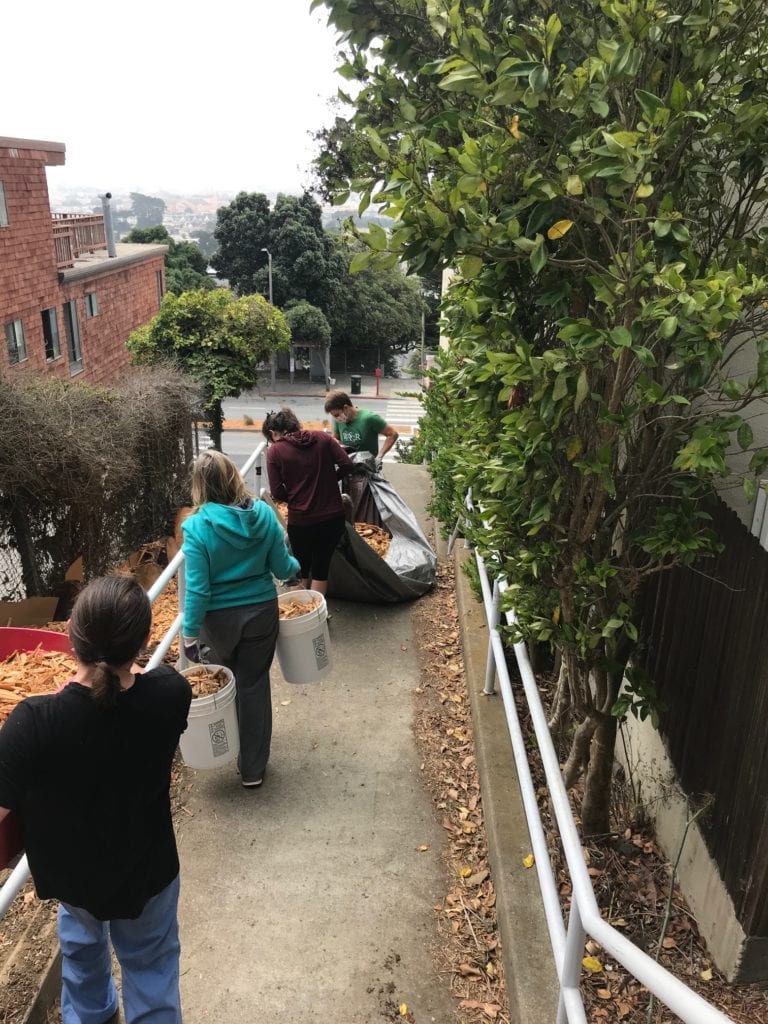
In the midst of the COIVID-19 pandemic, San Francisco needs more inviting outdoor spaces to pause and enjoy being outdoors. Which is why Sunnyside neighbors aren’t stopping in their efforts to beautify one of the City’s lesser-known stairways.
“We are continuing to clean up the Detroit Steps,” Suna Mullins emailed the Glen Park News on September 27, eight months into the pandemic and seven days after a Detroit Steps Project work party.
The project launched on November 3, 2018 and is a multi-year, multi-phrased beautification effort by the Sunnyside Neighborhood Association and neighbors to improve a long-neglected public right of way.
The Detroit stairs are a two-block stairway comprising 186 steps in total that run south from Detroit Street to Hearst Avenue and north from Detroit Street to Joost Avenue, bisected by Monterey Boulevard. The swath of land on each side of the step is classified by San Francisco as an “unaccepted” street, which means it is the adjoining property owner’s responsibility to maintain the property contiguous to the steps.
To this end, Rosaura Valle, the DSP leader, couldn’t be clearer.
“It is our hope that together we will make the Detroit Steps an appealing and inspirational place for commuters, walkers and residents,” Valle wrote on the Sunnyside Neighborhood Association website when they launched the project two years ago.
While COVID-19 may slow volunteers, it hasn’t deterred them. Valle and her 15-member Detroit Steps Project steering committee have met unfailingly —if virtually — in the months since the health crisis burst upon the San Francisco scene in February.
“The steering committee meets via Zoom on the first Tuesday of each month,” said Suna Mullins, a member of the DSP leadership team and its communication spokesperson.
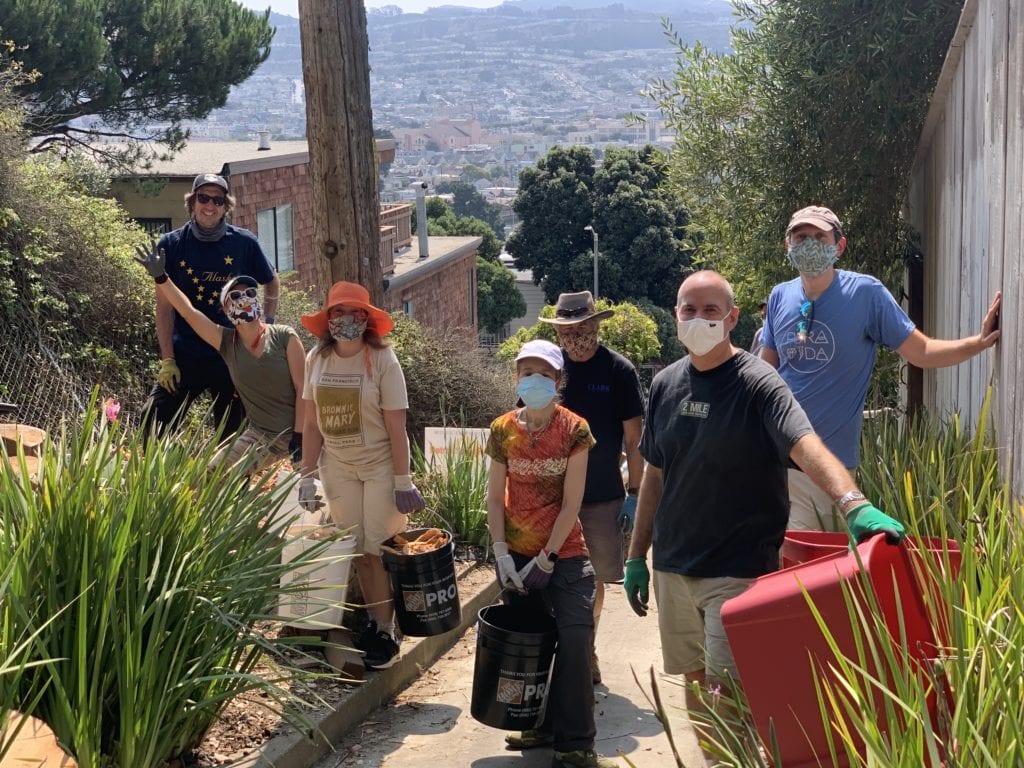
pictured left to right – Peter Myers (Detroit Street), Ken Hollebeck (Joost Avenue), Taylor Hughes (Joost Avenue), Jenny Marabello, Staples Avenue, Rosaura Valle (Hearst Avenue) September 20, 2020 Photo by Pam Parker Sousa (Murphy)
Since COVID struck the DSP has sponsored several work parties, with each volunteer safely masked.
The two most recent ones were on the September 19-20 weekend and October 4.
“We call them “Cleaning Up Days” where we come out and weed, weed, and weed,” emailed Mullins. “But this doesn’t preclude neighbors such as Daryl Browne and Joy Durighello spending hours on their own weeding and removing litter on the Upper Steps.”
“On September 20, 11 volunteers carried mulch from Joost down the steps,” added Valle, “and placed it on terraces designed and built by Daryl and his son, Ian, Bart Murphy and Pam Parker Souza (Murphy’s) son, Sebastian.”
But most of the heavy lifting occurred on September 19 and continued the next day when Bart Murphy and his brother, Bill, using a handcart, hefted some 22 redwood and pine stumps down the steps from Joost Avenue and positioned them midway between Joost Avenue and Monterey Boulevard.
The stumps came from the grounds of the Ruth Asawa School of the Arts,” said Mullins.
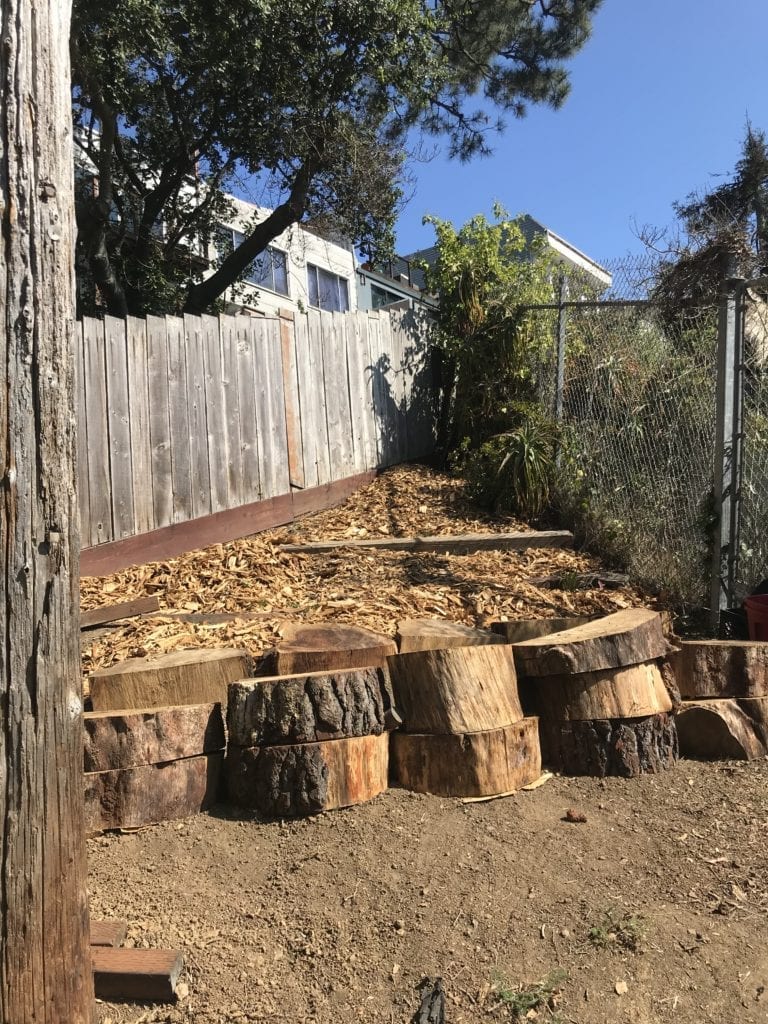
82 and in need of some love
First constructed before 1938, the Lower Steps were complemented a generation later by the Upper Steps and have been neglected for decades. Over time they became blighted with detritus and overgrown with weeds, a safety hazard, a depository for illegal dumping, vandalism and troublesome loitering. The absence of street lighting contributed to an already problematic situation.
On February 23, 2019, one year before COVID, the DSP scheduled its kickoff event with its first community clean-up and beautification fundraiser. Since then the Lower Steps have been refashioned with numerous plants, seeded by a $25,000 District 7 Budgeting Award, the money earmarked for landscaping and preparation of terracing the stairway slope.
Money from City coffers, however, didn’t mean that residents haven’t dug into their own pockets.
“The impressive landscape in front of the green house on the Lower Steps was all done by Gregoire Pean and Flora Clergue, members of our group,” emailed Mullins. “They procured the plants and a drip system and pay the water bill. Similarly, a neighbor on the eastern side of the cul-du-sac does caretaking on her own.”
“Gregoire and Flora are the Lower Steps stewards and are both passionate about gardening and bring solid experience to the DSP, particularly in mastering climate, soil, plant needs and plant choice,” emailed Rosaura Valle.
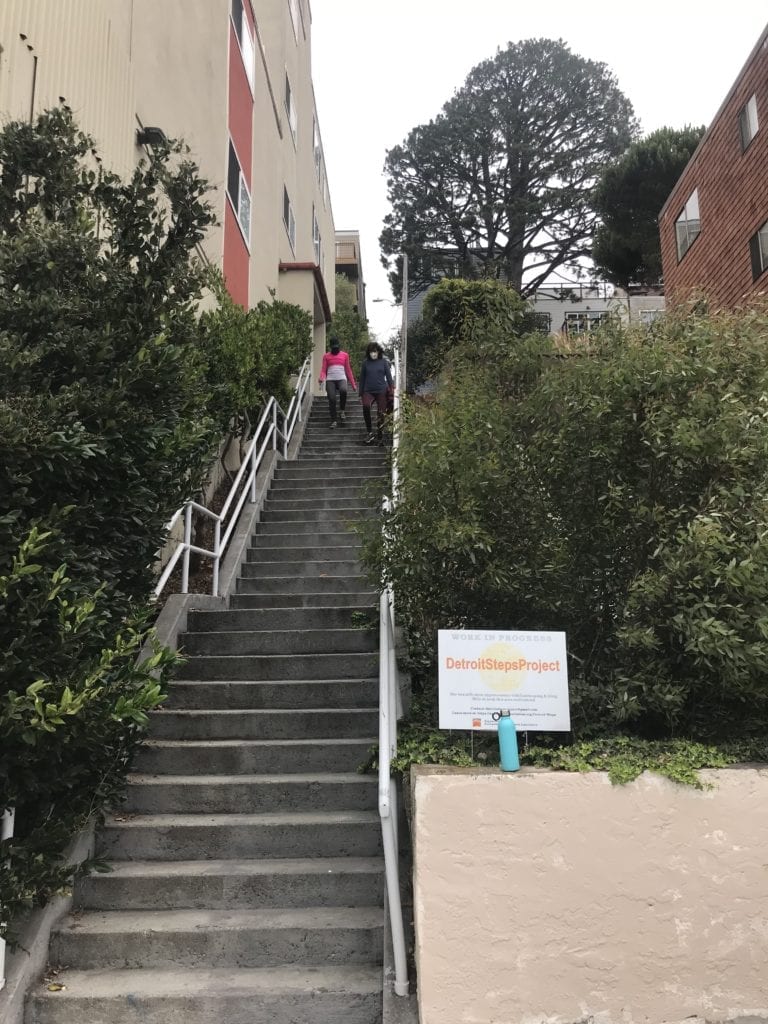
After almost two years of growth and irrigation, the Lower Steps cul-du-sac is quilted with a variety of Australian flora such as blue hibiscus, Grevilleas, Banksias and Chorizema that work well given the tough conditions of Detroit steps slope. It’s a restoration Mullins and Valle hope can spur small business development along the Monterey Boulevard corridor.
But on October 4 they turned their attention to the Upper Steps and completing September 20 work of shouldering mulch down the stairway.
The two women worked with Joy Durighello, who lives on Martha Avenue, Stacie Katz, who lives on Monterey Boulevard, and Monica Collins, who lives on Hearst Avenue. For three hours they took turns descending the 54 steps from Joost Avenue, handling tarps or hauling pails of wood chips. The mulch carpeted the slope, readying it for shrubs envisioned for later when funds permit.
Over the last two years the DSP, enlisting the efforts of City College of San Francisco students, sponsored a competition and awarded a winning design to a student who created a landscaping scheme for the Upper Steps.
“We collaborated with a Landscape Design Class at City in October 2019,” said Rosaura Valle. “We selected three finalists, presented their designs at a SNA meeting this February and are in the process of selecting a winning drawing.”
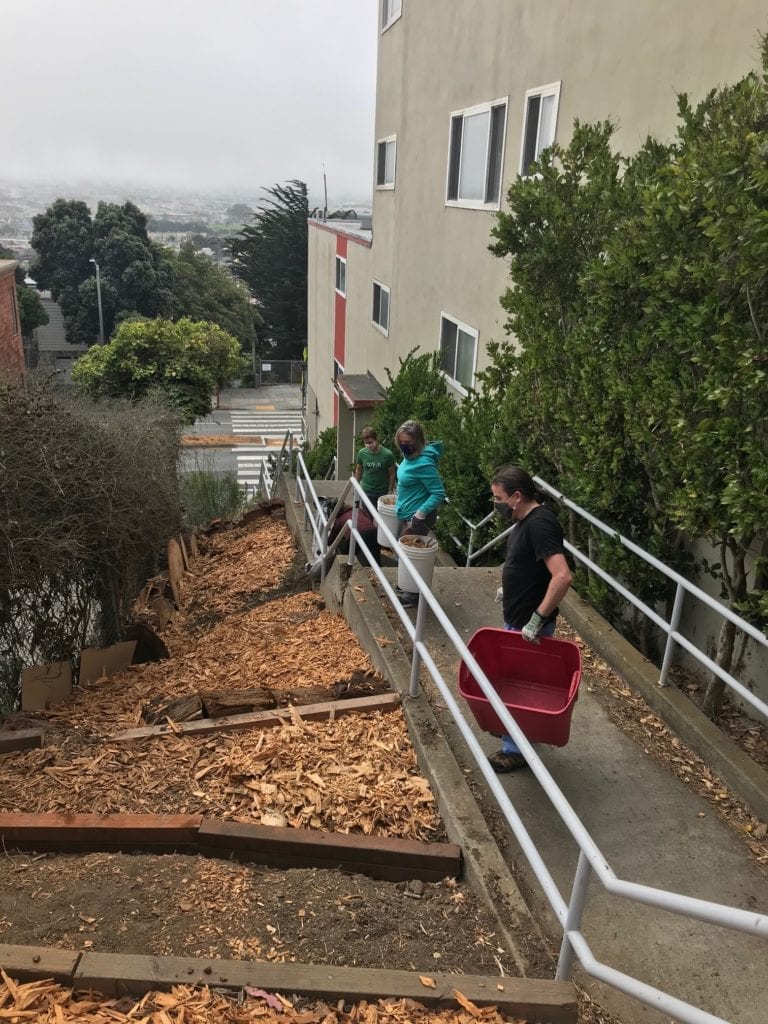
More to come
A fiscally sponsored group of the San Francisco Parks Alliance, the DSP is gearing up to apply for a Community Challenge Grant, a City funding mechanism that has been providing awards to community groups, schools and nonprofits since 1991 to make improvements in their neighborhoods.
They hope to take the project through June 2022 and include pedestrian decorative safety lighting, landscaping along the Upper Steps and at the entrance to the Lower Steps new fencing and a new bronze archway made from materials similar to those at the Sunnyside Conservatory.
“We hope it will feature a wrought iron design reminiscent of the sun and will become a local symbol, adding character to the Sunnyside,” said Valle.
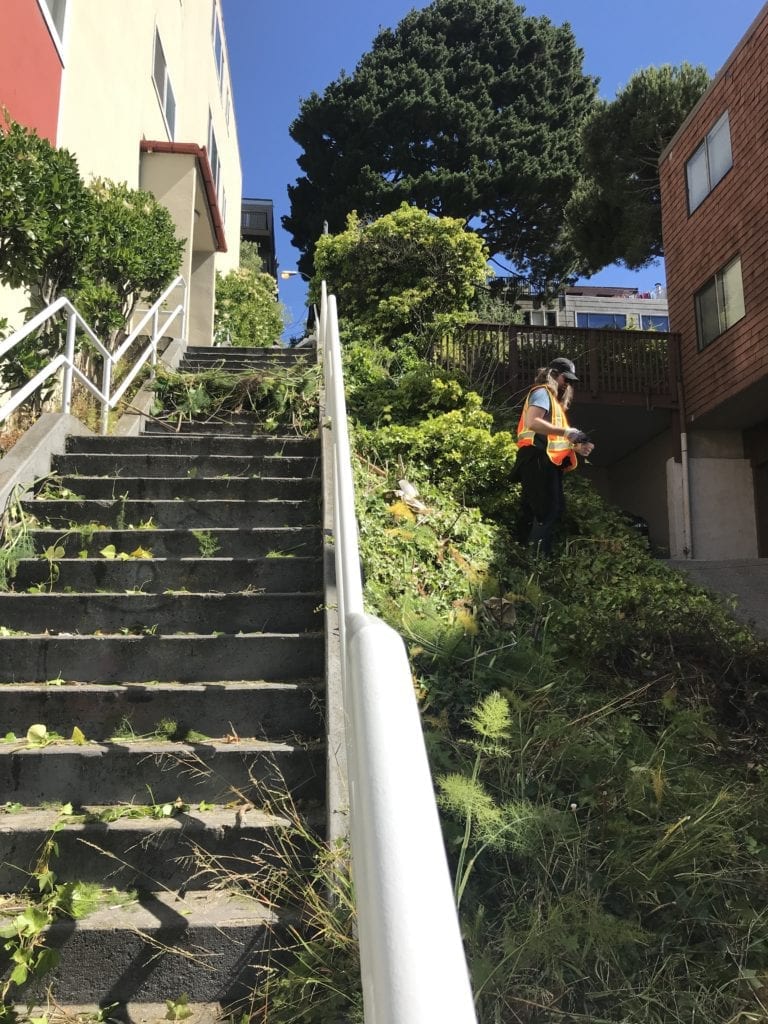
They will submit the Detroit Steps Project Community Challenge Grant proposal on November 20, then wait to learn if the DSP becomes a recipient in March 2021.
“It’s been a slow process,” she said, “but we are a determined group,” said Suna Mullins.
Making a mountain into a molehill
While they worked on October 4, the five women made way for strollers, dodged dog walkers and even pivoted for a jogger who circled up and down the stairway. Returning repeatedly to Joost Avenue, they wielded shovels, whittling away at the mountain of mulch that had been donated by San Francisco-based arborist CC Tree Design Group.
Mullins estimated the mulch at 1,000 pounds and by afternoon’s end the mountain was reduced to a molehill.
Stacie Katz, who grew up in the shadow of Mt. Davidson and only a block or so from O’Shaughnessy Hollow, has lived on Monterey Boulevard for a dozen years. She took a moment out, sitting on one of two dozen redwood stumps that the Murphy brothers had transported from the Ruth Asawa School of the Arts.
Her perch, situated half-way between Joost and Monterey, was sequestered in an alcove Rosaura Valle dubs the “Midway.”
The circle of stumps cushioned on a carpet of mulch gives the Midway a rustic feel. Its seven distinct terraces will each eventually house greenery giving the neighborhood an inviting green space in the middle of a busy block.
“This was a hangout place, riddled with 20-years of broken glass and dirty old clothes,” Katz said, manipulating a protective mask so it fit more comfortably.
“The Midway can become a source of wellbeing,” said Valle, envisioning paving and flag stones and even a bench complementing the wood chips and stump rounds.
DPW is also working with the DSP to install an Upper Steps water meter that will lead to the water main on Joost. Part of the DSP awarded District 7 Participatory Funds will go towards paying for the water to irrigate the plantings.
“Installation of the water meter by DPW is an in-kind service from SFPUC,’ said Valle. “With COVID, of course, plans were delayed, but we are confident we will get the meter by the end of the year.”
Valle and Mullins continue brainstorming with DPW about lighting on both the Upper and Lower stairs, detailed in Phase III of the DSP Community Challenge Grant.
Stacie Katz designed the signs that punctuates the soil at several different places along the steps. She also turns her hand at slideshows and online voting and acts as a liaison to the apartment building adjacent to the Upper Steps.
“This is a high-density neighborhood,” she said, echoing Valle, who works closely with Supervisor Norman Yee’s office on the project. “This spot, with its scenic views, especially since COVID, offers recreational users a place to sit outside in a socially distanced fashion.”
On October 4 the view, which includes Balboa High School, was shrouded by grey clouds, a relief from unseasonable heat and poor air quality caused by summer and fall Northern California wildfires.
Joy Durighello has a decades long history with the stairway. The DSP volunteer has traversed it for 27 years, making her way back and forth to CCSF where she taught English.
Relaxing for a moment from ferrying wood chips down the steps, she tugged at a black fleece vest, fending off the day’s chill.
“What a mess it was,” she said. “I walked down the steps one morning and watched a work party remove broken glass. I thought to myself, ‘What a hypocrite I’d be if I didn’t lend a hand.’” She’s a year in and has no intention of slowing down.
Near the end of the October 4 work party, Mullins stood next to Durighello, who stabbed absently at wood chips with the toe of a worn boot.
“As soon as the rain begins,” the Martha Avenue resident said, “I’m going to work on two terraces and plant yarrow, manzanita and Douglas iris.”
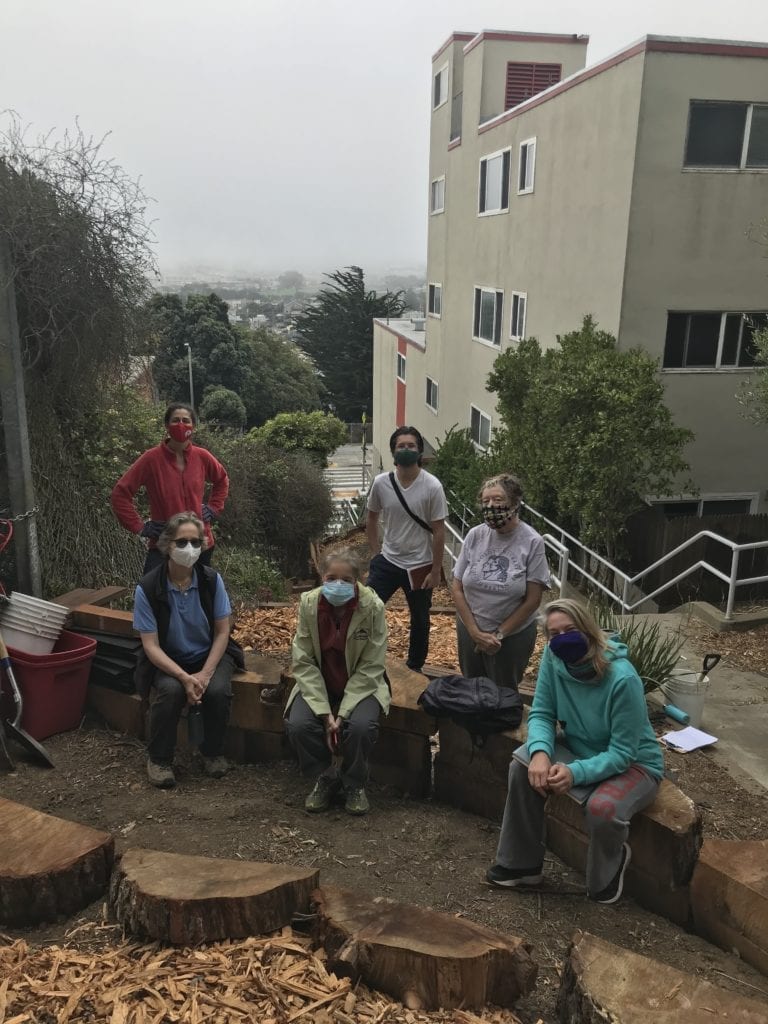
‘
.